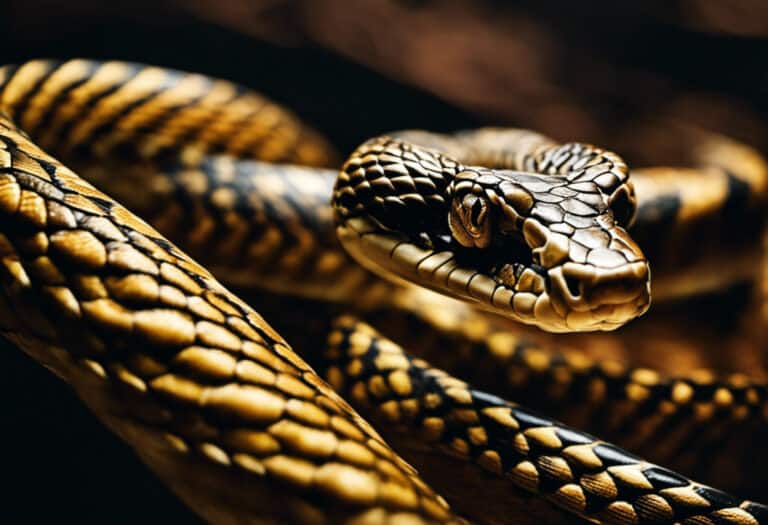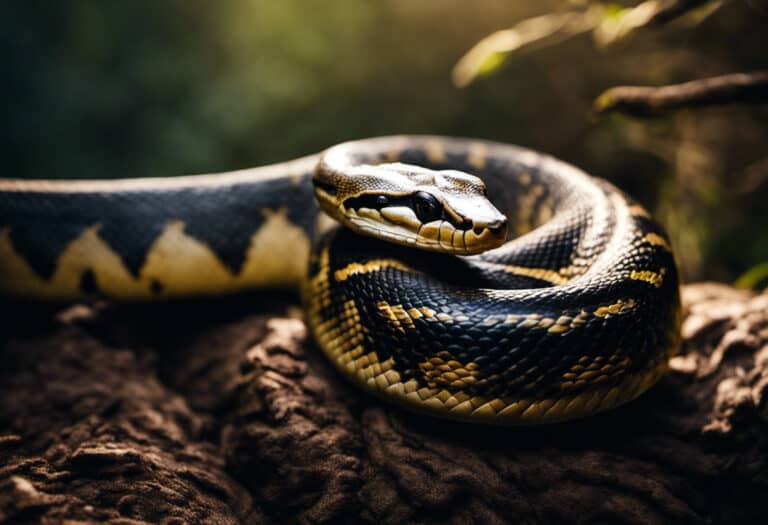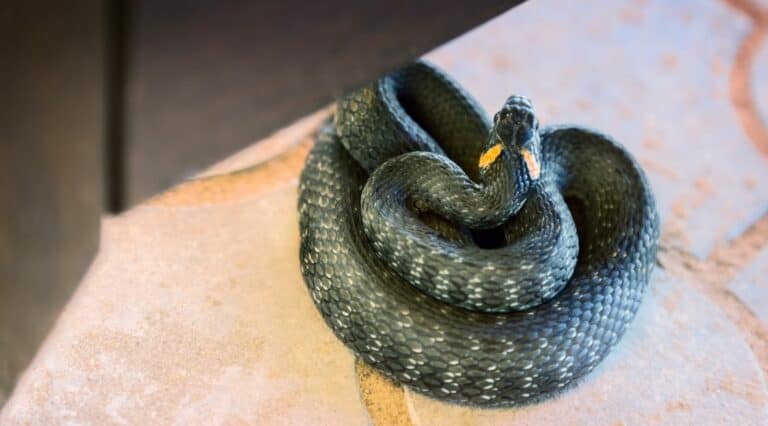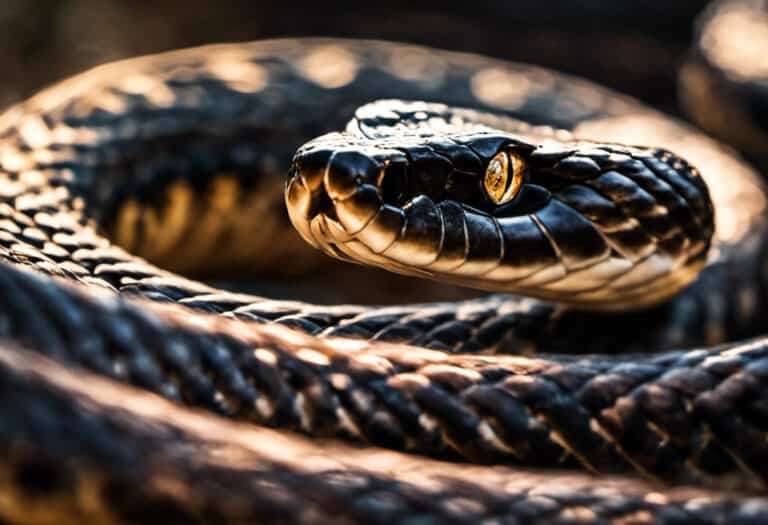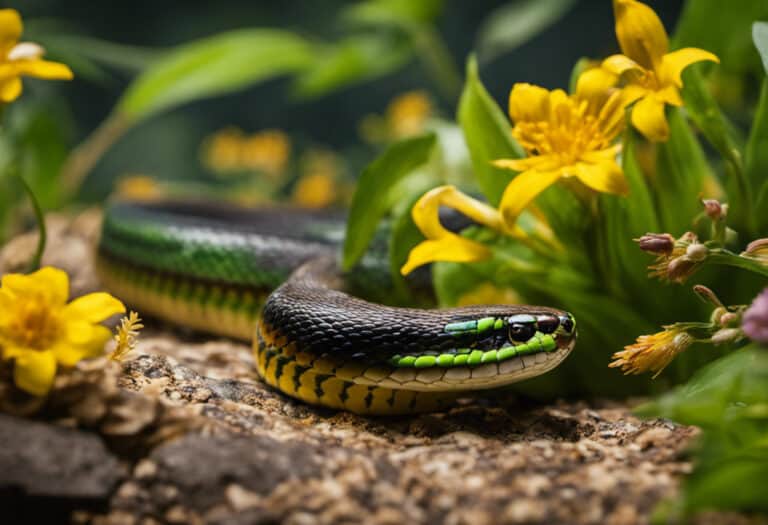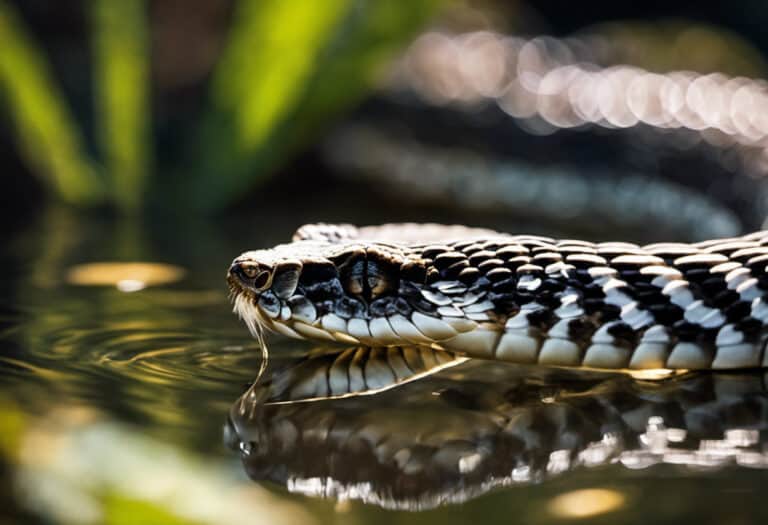Do All Snakes Eat Meat?
Do you ever wonder what snakes eat? Well, here’s an interesting fact: all snakes are carnivorous!
In this article, we’ll delve into the fascinating world of snake diet and feeding habits. You’ll discover the various types of snakes and their unique dietary preferences, as well as the importance of providing them with a proper and balanced diet.
So, if you’re curious to learn more about these remarkable creatures and their carnivorous nature, keep reading to unravel the secrets of what snakes eat.
Key Takeaways
- Snakes are carnivores and their diet consists of small mammals, birds, reptiles, fish, insects, and amphibians.
- Snakes swallow their prey whole as they are unable to chew.
- The specific diet and feeding frequency of snakes depend on their species, age, size, and activity level.
- Snakes can go for weeks or even months without eating and have a slow metabolism that allows them to survive on infrequent meals.
Different Types of Snakes and Their Diets
Some snakes, such as pythons and boas, have a diet that includes larger prey like rabbits and birds.
These snakes are known as constrictors, as they use their powerful bodies to squeeze and suffocate their prey before swallowing them whole.
In captivity, it’s important to provide these snakes with a diet that closely resembles their natural prey.
This means offering them appropriately sized rodents, such as mice or rats, as well as occasionally introducing larger prey like rabbits. It’s crucial to ensure that the prey is of high quality, free from any diseases or parasites.
Snakes have a keen sense of smell and are attracted to the scent of their preferred prey, making it important to offer them fresh and nutritious food.
By providing snakes with a diet that mimics their natural feeding habits, we can ensure their health and well-being in captivity.
Understanding the Carnivorous Nature of Snakes
Understanding the carnivorous nature of snakes, you’ll find that their diet primarily consists of small mammals, birds, reptiles, fish, insects, and amphibians. In the wild, snakes rely on their hunting abilities to catch and consume their prey. They use their keen sense of smell to locate their next meal, then strike and immobilize it with either venom or constriction.
Snakes have flexible jaws that allow them to swallow prey whole, as they’re unable to chew. However, when it comes to feeding pet snakes, there are challenges. Finding appropriate prey can be difficult, especially for larger species.
Some owners opt for commercially available frozen prey, which can be thawed and offered to the snake. It’s important to avoid feeding live prey, as it can cause stress and potential harm to the snake.
The Importance of a Balanced Diet for Snakes
To ensure the health and well-being of your snake, it’s crucial to provide them with a balanced diet.
A balanced diet for snakes consists of a variety of prey items that provide the necessary nutrients, vitamins, and minerals.
This helps support their growth, development, and overall metabolic functions.
Nutritional Needs of Snakes
Snakes require a diet that consists mainly of small mammals, birds, reptiles, fish, insects, and amphibians to meet their nutritional needs. These carnivorous reptiles have specific dietary requirements to ensure their health and survival.
In addition to their food, snakes also require proper hydration and an optimal temperature for digestion. Hydration is crucial for snakes as it aids in their overall well-being and helps maintain their bodily functions. Access to a large, clean water bowl is essential to keep them hydrated.
Temperature plays a significant role in snake digestion as it affects their metabolic rate. Snakes are ectothermic, meaning their body temperature is regulated by their environment. The right temperature allows for proper digestion and nutrient absorption.
It’s important to provide snakes with a suitable temperature gradient in their enclosure to support their digestion process and overall health.
Feeding Challenges and Solutions
If you’re experiencing difficulties with feeding your pet snake, consulting with a reptile veterinarian can provide you with helpful solutions. Feeding challenges in captive snakes can arise due to various reasons, but there are alternatives to live prey that can be considered.
Here are some important points to keep in mind:
-
Dietary Options: Instead of relying solely on live prey, you can opt for commercially available frozen prey. These prey items are nutritionally sufficient and can be thawed before offering them to your snake.
-
Feeding Frequency: Feeding frequency depends on your snake’s age, size, and activity level. Smaller or younger snakes usually eat twice a week, while larger, more mature snakes typically eat once a week or every two weeks.
-
Appetite Issues: If your snake isn’t showing interest in food, it could be due to various factors like stress, shedding, or health issues. Seeking veterinary advice is recommended to identify and address the underlying cause.
Factors Affecting Snake Feeding Frequency
Several factors influence the feeding frequency of snakes.
The age of the snake plays a crucial role, with younger snakes requiring more frequent meals compared to adults.
Additionally, the size of the snake and its species also determine the feeding schedule, as smaller species may need to eat more often than larger ones.
Age and Feeding Frequency
As a snake owner, you should be aware that the feeding frequency of your snake will vary depending on its age. Younger snakes require more frequent feedings as they’re growing rapidly. Smaller snakes may need to eat more often than larger snakes.
Another factor that can affect the feeding frequency is the activity level of the snake. Snakes that are more active may require more frequent feedings to meet their energy needs. On the other hand, less active snakes may need to be fed less often.
The reproductive status of the snake also plays a role in determining the feeding frequency. Female snakes approaching breeding season may require more frequent feedings to support egg production.
To ensure that you are feeding your snake properly, it is important to observe its response to food and adjust the feeding frequency accordingly. If you are unsure about the specific feeding recommendations for your snake based on its age and species, it is best to consult with a veterinarian or experienced snake breeder.
Size and Feeding Schedule
To ensure your snake’s proper nutrition and health, it’s crucial to adjust the feeding schedule based on its size. Snake feeding patterns can vary depending on the snake’s size and species. Factors influencing feeding frequency include the snake’s age, activity level, and metabolism.
Smaller or younger snakes usually eat more frequently, typically twice a week. Larger, more mature snakes generally eat once a week or every two weeks. Female snakes approaching breeding season may require more frequent feeding.
It’s important to observe your snake’s response to food, as it will indicate its hunger and feeding needs. Remember, overfeeding can lead to obesity and health issues, so it’s essential to find the right balance for your snake’s size and nutritional requirements.
Identifying the Causes of Decreased Appetite in Snakes
If your snake is experiencing a loss of appetite, it’s important to identify the underlying causes to address the issue effectively. There are several potential reasons why your snake may be anorexic, including stress, environmental factors, hibernation, shedding, pregnancy, or breeding season anorexia.
However, it’s crucial to also consider more serious causes such as health issues like cancer, kidney failure, or parasites. Symptoms of malnutrition in snakes may include weight loss, lethargy, dull skin, and weakened immune system.
To determine the cause of decreased appetite, a thorough physical examination and laboratory testing by a veterinarian are recommended. Once the underlying cause is identified, appropriate treatment can be implemented to restore your snake’s appetite and overall health.
Seek veterinary advice to ensure the well-being of your snake.
Proper Water Requirements for Healthy Snakes
Make sure you provide your snake with a large, heavy ceramic bowl filled with fresh clean water at all times to ensure proper hydration and aid in shedding.
Snakes require access to clean water for their overall health and well-being. Maintaining proper hydration is crucial for snakes to thrive.
Lack of hydration can lead to various health issues, including dehydration, kidney problems, and difficulty shedding. Here is a table outlining common water-related health issues in snakes and their potential causes:
| Health Issue | Potential Causes |
|---|---|
| Dehydration | Insufficient water intake, high temperatures |
| Renal Failure | Poor water quality, bacterial infections |
| Incomplete Shedding | Low humidity levels, inadequate access to water |
| Blister Disease | Dirty water, unsanitary living conditions |
| Respiratory Infections | Dry environment, lack of humidity, contaminated water |
Key Information About Feeding Pet Snakes
Feeding your pet snake a diet specific to its species, age, size, and activity level is essential for its overall health and well-being. Here is some key information to consider when it comes to feeding your pet snake:
-
Snake Diet Comparison:
-
Snakes are carnivores and their diet varies based on the species.
-
Some snakes eat warm-blooded prey such as rodents, rabbits, and birds, while others eat insects, amphibians, eggs, reptiles, fish, earthworms, or slugs.
-
Popular pet snakes often eat mice, rats, gerbils, and hamsters, while larger pet snakes may consume whole rabbits.
-
Feeding Strategies for Picky Eaters:
-
Some snakes can be picky eaters and may refuse certain types of food.
-
Experiment with different prey items to find what your snake prefers.
-
If your snake consistently refuses to eat, consult a veterinarian for guidance.
-
Feeding Frequency:
-
Feeding frequency depends on the snake’s age, size, and activity level.
-
Smaller or younger snakes usually eat twice a week, while larger, more mature snakes typically eat once a week or every two weeks.
-
Female snakes approaching breeding season may require more frequent feeding.
Remember to always provide clean water and seek veterinary advice if your snake’s appetite decreases or if you have any concerns about its diet.
The Fascinating Eating Habits of Snakes
You’ll be amazed by the unique eating habits of snakes, such as swallowing their prey whole and being able to consume meals larger than their own head. Snakes have evolved remarkable feeding techniques and adaptations that allow them to survive and thrive in their environments.
One of these adaptations is their ability to dislocate their jaws, which enables them to open their mouths wide and swallow prey much larger than themselves. They use their sense of smell to locate their prey, then strike and immobilize it with venom or constriction.
Once the prey is subdued, the snake unhinges its jaws and begins the process of swallowing it whole. The prey moves down the snake’s throat through a series of muscular contractions.
Temperature also plays a crucial role in snake digestion. Snakes are ectothermic, meaning they rely on external sources of heat to regulate their body temperature. This temperature is essential for the effective functioning of their digestive system.
Snakes often bask in the sun or seek warm spots in their environment to raise their body temperature, which in turn speeds up their metabolic processes, including digestion. The warmth aids in breaking down the prey’s tissues and facilitates the absorption of nutrients.
Therefore, maintaining an appropriate temperature is vital for snakes to efficiently digest their meals and extract the necessary nutrients for their survival.
Why Cooked Meat Is Not Suitable for Snakes
Avoid feeding cooked meat to your snake as it lacks the necessary nutrients and can lead to health problems and malnutrition.
-
Feeding Methods for Snakes:
-
Snakes are carnivores and their diet mainly consists of small mammals, birds, reptiles, fish, insects, and amphibians.
-
Snakes swallow their prey whole, as they’re unable to chew.
-
They use their sense of smell to locate prey and strike to immobilize it with venom or constriction.
-
Snakes have flexible jaws that allow them to consume prey larger than their head.
-
The Role of Enzymes in Snake Digestion:
-
Raw meat provides essential enzymes and nutrients that snakes need for proper digestion.
-
The high temperatures used in cooking can denature proteins, making them less nutritious for snakes.
-
Enzymes in the snake’s digestive system help break down proteins, fats, and other nutrients from raw meat.
-
Consequences of Feeding Cooked Meat to Snakes:
-
Feeding cooked meat to snakes can result in health problems and malnutrition due to the lack of essential nutrients.
-
Cooked meat may also contain additives or seasonings that can be harmful to snakes.
-
It’s crucial to provide snakes with a diet that closely resembles their natural prey to ensure their overall health and well-being.
Frequently Asked Questions
Can Snakes Survive on a Vegetarian Diet?
Snakes cannot survive on a vegetarian diet. Their nutritional requirements are specific to a carnivorous diet. A vegetarian diet would have a negative impact on snake behavior and health.
Do All Snakes Eat Prey That Is Still Alive?
Snakes typically prefer to eat live prey, but it depends on the species. Some snakes have a preference for certain types of live prey, such as rodents or birds. However, commercially available frozen prey is a suitable alternative.
How Often Do Snakes Need to Eat to Stay Healthy?
Snakes’ feeding frequency varies depending on their species, age, and size. Young snakes require more frequent meals, while larger species can eat less often. Factors like metabolism, growth rate, and activity level influence their dietary needs.
Can Snakes Eat Fruits or Vegetables as Part of Their Diet?
Snakes have specialized digestive systems designed for meat. Their bodies lack the enzymes needed to break down plant matter efficiently. Therefore, fruits and vegetables are not essential in a snake’s diet.
Are There Any Snakes That Eat Other Snakes?
Snake cannibalism, while not common, does occur in certain snake species. Some snakes may prey on other snakes, acting as both predators and prey. The dynamics of snake on snake predation are complex and vary among different species.
Conclusion
In conclusion, snakes are truly fascinating creatures with their unique dietary preferences. They have a wide range of food choices, from warm-blooded prey to insects and even fish. It’s important to provide them with a proper and balanced diet to ensure their overall health and well-being.
However, be cautious as cooked meat isn’t suitable for snakes. So, remember to feed your scaly friends with the right food to keep them happy and healthy.
